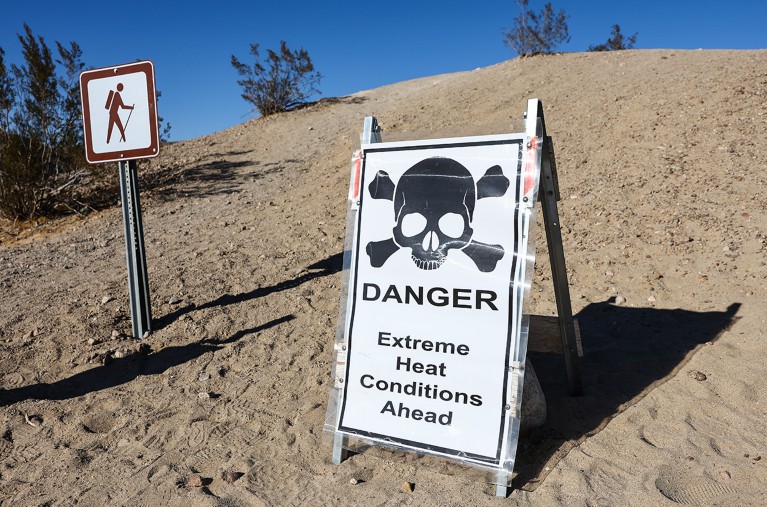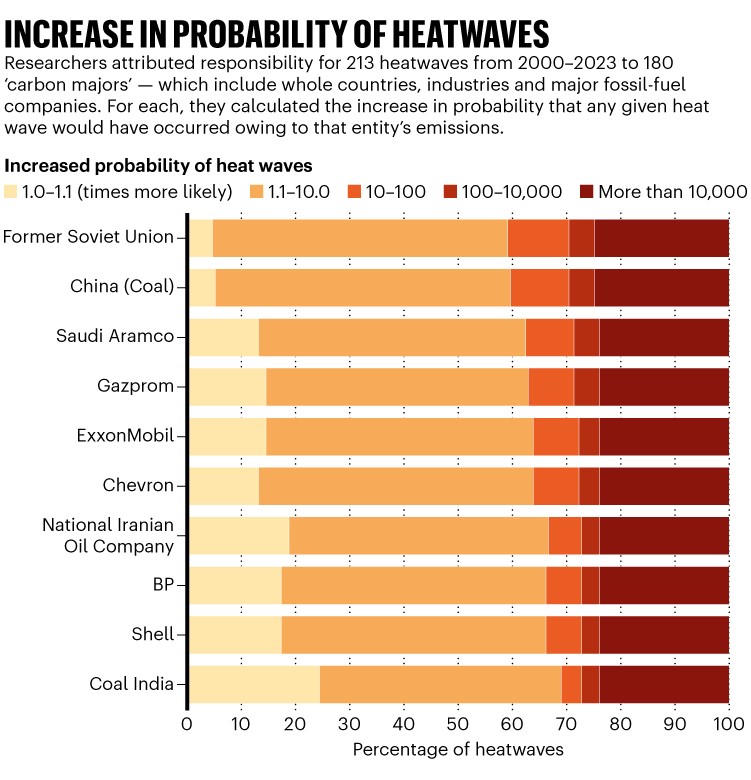You have full access to this article via your institution.
Hello Nature readers, would you like to get this Briefing in your inbox free every day? Sign up here.

Heatwaves are getting more severe, and more frequent. Credit: Mario Tama/Getty
Around one-quarter of the heatwaves recorded between 2000 and 2023 can be directly linked to greenhouse-gas emissions from individual energy giants. Of the 213 heatwaves recorded, the emissions linked to energy companies and other major carbon emitters increased the likelihood of some 53 by a median factor of more than 10,000. The findings could provide fresh evidence to support lawsuits seeking to hold companies accountable for their impacts on the climate. “We absolutely can allocate blame, and we absolutely should,” says climate scientist Karsten Haustein.

Source: Ref. 1
Neurons in a brain region called the bed nucleus of the stria terminalis (BNST) act as a ‘dial’ that can turn the desire to eat on or off in mice. Researchers found that silencing these neurons made hungry mice stop eating, and that activating them in recently-fed mice spurred the animals to gorge on whatever was available — water, bitter substances and even plastic pellets. If a similar dial exists in humans, the ability to manipulate it could yield treatments that help people to eat when they have no appetite, or keep them from overeating.
Using the Laser Interferometer Gravitational-Wave Observatory (LIGO), researchers have confirmed the late Stephen Hawking’s theorem that the surface area of a black hole can never decrease. Physicists detected the gravitational waves of two black holes fusing together, and later the vibrations produced by the single black hole birthed by the collision. Analysis of this ‘ringdown’ showed that the resulting black hole had a surface area of 400,000 square kilometres — almost double the combined surface area of its parents. The discovery was “the perfect ten-year anniversary gift” for LIGO, says physicist Katerina Chatziioannou.
Reference: Physical Review Letters paper
Medical researchers at some institutions in Canada, the United States and Italy are using ‘synthetic data’ — data created by an artificial intelligence tool trained on real patient information — to conduct studies without the need for ethical approval. The use of synthetic data can speed up research by making it easier to share data between sites without risking patient privacy, says medical AI researcher Khaled El Emam. However, some legal scholars warn that the boundary between identifiable and anonymous can be murky, and are calling for governing bodies to draw up more explicit guidelines for how and when synthetic data can be used.
Features & Opinion
Biobanks — repositories of genetic sequences, images and physical samples of bodily fluids and tissues — are treasure troves of biomedical research data. For many researchers, biobanks can mean the difference between a successful project and one that stalls for want of crucial data. But surveys suggest they’re underutilized, with only around 10% of samples being used. Choosing a biobank that balances the number of samples you need, the costs involved and potential shipping restrictions is a strategic consideration, says health-policy researcher Amanda Rush. But whatever your needs, there are different scenarios for which each type of biobank “comes to the fore”, she says.
Today I’m considering starting a collection of cassette tapes of all my favourite albums. To avoid taking up too much space, I could limit my collection to just one: a newly designed cassette tape that can hold up to 36 petabytes of data — enough to store every song ever recorded.
The cassette stores information by coding it as a DNA sequence, then printing synthetic DNA molecules onto plastic tape. But unfortunately for the purposes of my collection, it can’t play music — I’d need a tape player that can read DNA sequences, which to my knowledge doesn’t exist…. yet.
While I dig out my Walkman, why not send your feedback on this newsletter to [email protected].
Thanks for reading,
Jacob Smith, associate editor, Nature Briefing
With contributions by Flora Graham
• Nature Briefing: Careers — insights, advice and award-winning journalism to help you optimize your working life
• Nature Briefing: Microbiology — the most abundant living entities on our planet — microorganisms — and the role they play in health, the environment and food systems
• Nature Briefing: Anthropocene — climate change, biodiversity, sustainability and geoengineering
• Nature Briefing: AI & Robotics — 100% written by humans, of course
• Nature Briefing: Cancer — a weekly newsletter written with cancer researchers in mind
• Nature Briefing: Translational Research — covers biotechnology, drug discovery and pharma


